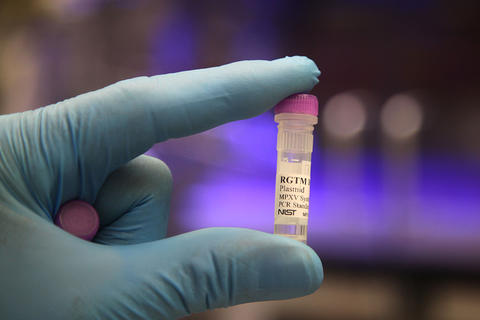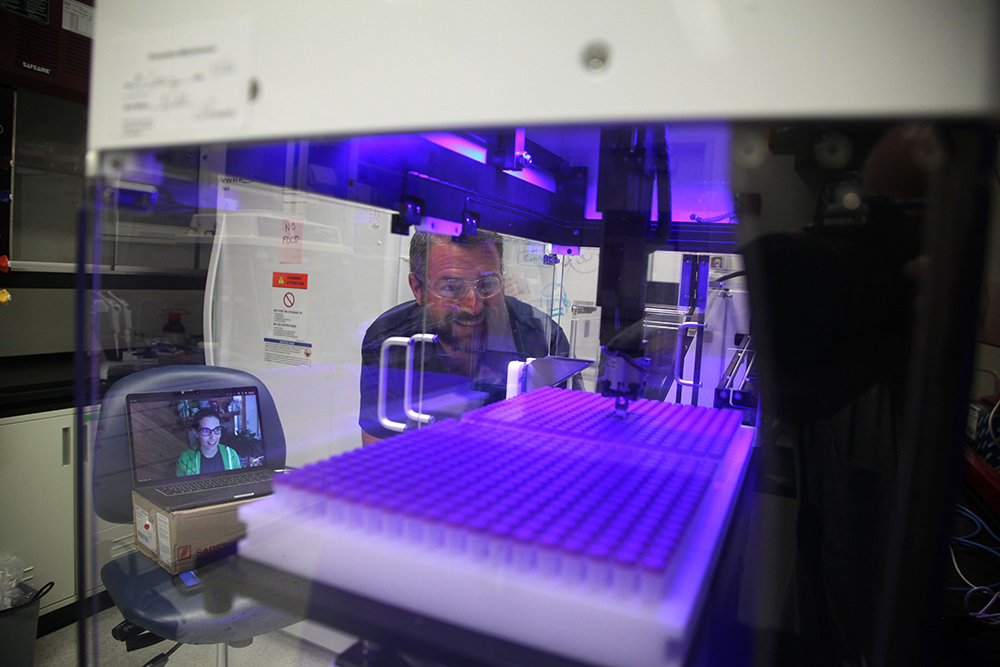NIST Develops Genetic Material for Validating Mpox Tests
NIST is making the new material freely available to testing laboratories and diagnostic test manufacturers worldwide.

A vial of the positive control material from NIST that can be used to help ensure the accuracy of tests for mpox.
In an effort to help speed the expansion of mpox testing in the U.S., the National Institute of Standards and Technology (NIST) has produced a material that can help ensure the accuracy of tests for the disease. NIST is making the material, which contains gene fragments from the virus that causes the disease but is noninfectious and safe to handle, freely available for use by test manufacturers and testing laboratories.
Mpox, formerly known as monkeypox, is spread by close contact and can cause fever, flu-like symptoms and skin lesions. More than 3,500 cases of mpox have been confirmed in the United States since the outbreak began in late May, and the World Health Organization has declared mpox to be a global health emergency.
Testing is necessary to identify the extent of an outbreak and contain it, and to properly care for people who have caught the disease and those who may have been exposed. The mpox test, like the most sensitive test for COVID-19, uses a technique called polymerase chain reaction, or PCR, to detect genetic sequences from the virus that causes the disease.
Because the material from NIST contains those genetic sequences, laboratories can use it as a positive control — that is, a sample that should cause a positive result if their test is working properly. As the U.S. Centers for Disease Control and Prevention (CDC) works to expand the nation’s testing capacity, the material from NIST will fill a growing need.
“Given the urgent public health need, we are getting this out as quickly as possible without compromising on quality.” —Scott Jackson, microbial geneticist at NIST
“Positive control materials are critical for ensuring the reliability of diagnostic tests,” said Victoria Olson, the CDC’s deputy director of laboratory science and safety. “Having a reliable supply of high-quality control material from a trusted source like NIST will help us mount an effective testing program more quickly.”
The NIST control material is a liquid solution containing partial sequences from nine mpox genes strung together into molecules of DNA roughly 3,400 base pairs, or letter pairs, long.
The value of the NIST control material isn’t in the DNA itself, which is relatively easy to synthesize. Rather, it is NIST’s assurance that each vial of the material contains the same very precisely measured amount of DNA, to a known degree of certainty. To wit: Each microliter contains 110,000 copies of the DNA strand, plus or minus 10%.
NIST scientists analyzed the DNA to ensure there are no errors in the genetic sequences. They measured the concentration of DNA in the material using a high-precision technique called digital PCR. And they worked with NIST statisticians to ensure that each microliter of the material contains the same amount of DNA, within the stated bounds of uncertainty.
“We do a lot of work to make sure we get those numbers right,” said Scott Jackson, the NIST microbial geneticist who led the effort.

On June 22, the U.S. Department of Health and Human Services announced that it would authorize commercial laboratories to conduct mpox tests, which previously were only conducted by a limited number of public laboratories. Commercial laboratories can use the material from NIST to validate their tests and to determine test sensitivity, which is the lowest amount of genetic material their tests can detect.
The NIST material can also be used when monitoring wastewater for the virus, which can indicate whether a virus is present in a community and how prevalent it is. This type of monitoring can be complicated by the fact that the virus becomes very diluted in wastewater, and researchers can use the control to ensure their tests are working properly.
In 2020, NIST released a similar positive control material for SARS-CoV-2, the virus that causes COVID-19. That material was used to help standardize tests for the disease.
NIST produces thousands of standard reference materials, or SRMs, which are used to ensure accurate measurements across many industries. The agency is releasing this positive control as a “research grade test material,” because it has not yet undergone the full battery of tests for it to be considered a NIST SRM. For example, the researchers are still studying how the measured characteristics of the material change over time.
“But given the urgent public health need,” Jackson said, “we are getting this out as quickly as possible without compromising on quality.”
NIST is making this material freely available to any test manufacturer or testing laboratory worldwide. Technical information and instructions for requesting the material are available on the NIST website.
This page was updated on Dec. 6, 2022, to reflect the World Health Organization’s decision to change the name of the virus from “monkeypox” to “mpox.”

